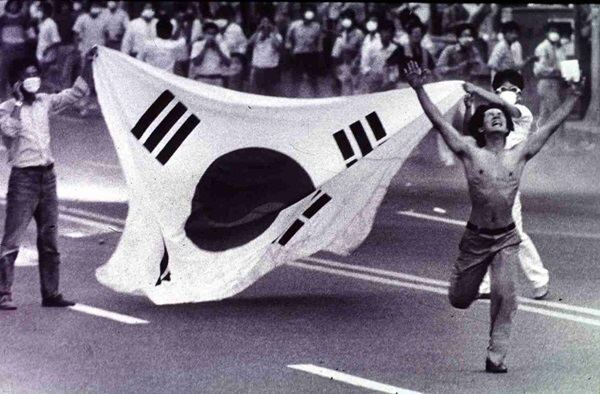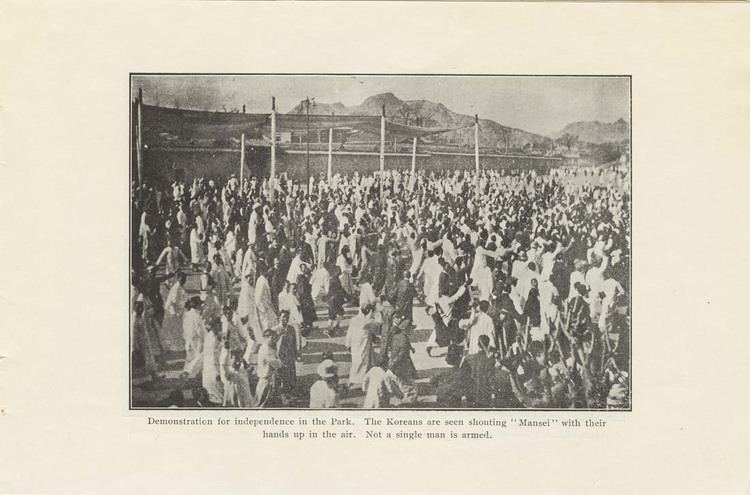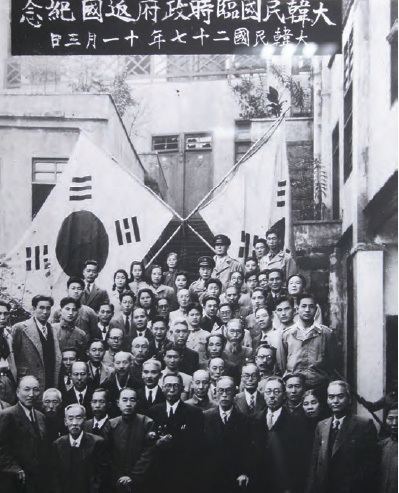Hangul 항일운동, 독립운동 End date 1945 | Hanja 抗日運動, 獨立運動 Location Korea | |
 | ||
Revised Romanization Hangil Undong, Dongnip Undong McCune–Reischauer Hangil Undong, Tongnip Undong | ||
Korean independence movement
The Korean independence movement was a military and diplomatic campaign to achieve the independence of Korea from Japan. After the Japanese annexation of Korea in 1910, local resistance in Korea culminated in the March 1st Movement in 1919, which was crushed and sent Korean leaders to flee into China. In China, Korean independence activists built ties with the Chinese Nationalist Government which supported their Korean government in exile (KPG). At the same time, the Korean Liberation Army, which operated under the Chinese National Military Council and then the KPG, led attacks against Japan.
Contents
- Korean independence movement
- That day ep 1 korean independence that day
- Before Japanese occupation of Korea
- Japanese rule
- World War II diplomacy
- Ideologies and concerns
- Tactics
- Types of movements
- Religious groups
- Expatriate groups
- Royalist influence
- Before Colonial Period
- Provisional Government
- Edification movement leaders
- Patriotic assassins
- Military leaders
- ReligionStudent leaders
- Historians
- Poets
- Communist leaders
- Foreign supporters
- References

After the outbreak of the Pacific War gave China global allies in its struggle against Japan, China attempted to use this influence to assert Allied recognition of the KPG. However, the United States was skeptical of Korean unity and readiness for independence, preferring an international trusteeship-like solution for the peninsula. Although China achieved agreement by the Allies on eventual Korean independence in the Cairo Declaration of 1943, continued disagreement and ambiguity about the postwar Korean government lasted until Soviet-Japanese War created a de facto division of Korea into Soviet and American zones, prompting the Korean War.

The date of the Surrender of Japan is now an annual holiday called Gwangbokjeol (literally "Restoration of Light Day") in South Korea, and Chogukhaebangŭi nal (literally "Fatherland Liberation Day") in North Korea.

That day ep 1 korean independence that day
Before Japanese occupation of Korea

The last independent Korean monarchy, the Joseon Dynasty, lasted over 500 years (1392-1910), both as the Joseon Kingdom and later as the Empire of Korea. Its international status and policies were conducted primarily through careful diplomacy with the power en vogue in China (during this period of time dynastic control of China saw the end of the Yuan Dynasty and the rise and fall of both the Ming Dynasty and the Qing Dynasty), though other interactions with other international entities were not absent. Through this maneuvering and a dedicated adherence to strict Neo-Confucianist foreign and domestic policies, Joseon Korea retained control over its internal affairs and relative international autonomy though technically a suzerain of the ruling Chinese dynasties for most of this period. These policies were effective in maintaining Korea's relative independence and domestic autonomy in spite of a number of regional upheavals and a number of invasions (including the Japanese invasions of Korea from 1592-98 as well as the First and Second Manchu invasions of Korea).
However, in the late 19th and early 20th centuries, with the rise of Western imperialism boosted by the Industrial Revolution and other major international trends, the weakening of China also made Korea vulnerable to foreign maneuvering and encroachment, both as a target in and of itself and as a stepping-stone to the "larger prize" of China. This period (roughly from 1870 until annexation by Japan in 1910) was marked in Korea by major upheavals, many intrigues, the inability of Joseon Korea and the later Empire of Korea to right itself amidst all of the maneuvering around it by larger powers (including, but not limited to, Imperial Russia, Japan, China, and to a lesser extent France, Great Britain, and the United States), revolts/insurrections, and other indicators of a turbulent time. By the end of the First Sino-Japanese War in 1895 it was evident internationally that China could no longer protect its international interests, much less its own, against its opponents, and that its attempts to modernize its military and institutions were unsuccessful.
Among other things, the Treaty of Shimonoseki that ended this war stipulated that China would relinquish suzerainty and influence over Korea, recognize Korea's full independence and autonomy, and end the tribute system which had linked China and Korea for many centuries. In practical reality, this stipulation implied the handover of primary foreign influence in Korea from China to Japan, as Japanese forces had taken positions in the Korean Peninsula during the course of the war. This paved the way for Imperial Japan to tighten its influence on Korea without official Chinese intervention. In 1905, the Eulsa Treaty made the Empire of Korea (Korean imperial status had been established in 1897 to put King Gojong on equal legal footing with his neighboring sovereigns and to fully sever Korea's superficial ties of suzerainty to China) a protectorate of Japan; in 1907, the Japan-Korea Treaty of 1907 stipulated that Korea's policies would be enacted and enforced under the guidance of the Japanese resident general; and in 1910, through the Japan-Korea Annexation Treaty, Japan officially declared its annexation of Korea, a move for which Japan had been preparing for an extended period of time. All of these treaties were procured under duress, and though under duress, Emperor Sunjong of Korea refused to sign any of them and considered them illegal and not binding (though he had no real power to oppose its enactment and enforcement).
As a side note, both the 1905 treaty (and by extension the 1907 treaty) and the 1910 annexation treaty were declared "already null and void" when the normalization of relations between the Republic of Korea and Japan was negotiated in 1965.
Japanese rule
The Japanese rule that ensued was oppressive to a far-reaching degree, giving rise to many Korean resistance movements. By 1919 these became nationwide, marked by what came known as the March 1st Movement.
Japanese rule was oppressive but changed over time. Initially, there was very harsh repression in the decade following annexation. Japan's rule was markedly different then in its other colony, Formosa. This period is called "amhukki", the dark period by Koreans. Tens of thousands of Koreans were arrested for political reasons. The harshness of Japanese rule increased support for the Korean independence movement. Many Koreans left the country, some of whom formed societies in Manchuria to agitate for Korean independence. Some went to Japan, where groups agitated clandestinely. There was a prominent group of Korean Communists in Japan, who were in danger for their political activities.
Partly due to Korean opposition to colonial policies, this was followed by a relaxation of some harsh policies. The Korean crown prince married the Japanese princess Nashimoto. The ban on Korean newspapers was lifted, allowing publication of Choson Ilbo and The Dong-a Ilbo. Korean government workers received the same wages as Japanese officials, though the Japanese officials received bonuses the Koreans did not. Whippings were eliminated for minor offenses but not for others. Laws interfering with burial, slaughtering of animals, peasant markets, or traditional customs were removed or changed.
After the Peace Preservation Law of 1925, some freedoms were restricted. Then, in the lead up to the invasion of China and World War II, the harshness of Japanese rule increased again.
World War II diplomacy
Although the Empire of Japan had invaded and occupied northeast China from 1931, the weak Nationalist Government of China tried to avoid declaring war against Japan until the Empire directly attacked Beijing in 1937, sparking the Second Sino-Japanese War. After the United States declared war on Japan in 1941, China became an Ally of World War II, and tried to exercise its influence within the group to support Asian anticolonialist nationalism, which included the demand of the complete surrender of Japan and immediate independence of Korea afterwards.
China tried to promote the legitimacy of the Provisional Government of Korea (KPG), which was established by Koreans in China after the suppression of the March 1st Movement in Korea. The KPG was ideologically aligned with the Chinese government of the time, as independence leader Kim Gu had agreed to Chiang Kai-shek's suggestion to adopt the Chinese Three Principles of the People program in exchange for financial aid. At the same time, China supported the leftist independence leader Kim Won-bong and convinced the two Kims to form the unified Korean Liberation Army (KLA). Under the terms in which the KLA was allowed to operate in China, it became an auxiliary of China's National Revolutionary Army until 1945. China's National Military Council had also decided that "complete independence" for Korea was China's fundamental Korean policy; otherwise, the government in Chongqing tried to unify the warring Korean factions.
Although Chiang and Korean leaders like Syngman Rhee tried to influence the US State Department to support Korean independence and recognize the KPG, the Far Eastern Division was skeptical. Its argument was that the Korean people "were emasculated politically" after decades of Japanese rule, and showed too much disunity, preferring a condominium solution for Korea that involved the Soviets. China was adamantly opposed to Soviet influence in Korea after hearing about Soviet atrocities in Poland since its "liberation". By the Cairo Conference, the US and China came to agree on Korean independence "in due course", with China still pressing for immediate recognition of the exile government and a tangible date for independence. After Soviet-American relations deteriorated, on August 10, 1945 the United States Department of War agreed that China should land troops in Pusan, Korea from which to prevent a Soviet takeover. However, this turnaround was too late to prevent the division of Korea, as the Red Army quickly occupied northern Korea that same month.
Ideologies and concerns
Although there were many separate movements against colonial rule, the main ideology or purpose of the movement was to free Korea from the Japanese military and political rule. Koreans were concerned with alien domination and Korea’s state as a colony. They desired to restore Korea's independent political sovereignty after Japan invaded the weakened and partially modernized Korean Empire. This was the result of Japan's political maneuvers to secure international approval for the annexation of treaty annexing Korea.
During the independence movement, the rest of the world viewed Korea's resistance movement as a racial anti-imperialist, anti-militarist rebellion, and an anti-Japanese resistance movement. Koreans, however, saw the movement as a step to free Korea from the Japanese military rule.
The South Korean government is criticized for not accepting Korean socialists who fought for Korean independence.
Tactics
There was no main strategy or tactic that was prevalent throughout the resistance movement, but there were prominent stages where certain tactics or strategies were prominent.
From 1905 to 1910, most of the movement’s activities were closed off to the elite class or rare scholar. During this time, militaristic and violent attempts were taken to resist the Japanese. Most of the attempts were disorganized, scattered, and leaderless to prevent arrests and surveillance by Japan.
From 1910 to 1919, was a time of education during the colonial era. Many Korean textbooks on grammar and spelling were circulated in schools. It started the trend of intellectual resistance to the Japanese rule. This period, along with Woodrow Wilson’s progressive principles, created an aware, nationalist, and eager student population. After the March 1st movement of 1919, strikes became prominent in the movement. Up to 1945, universities were used as a haven and source of students who further supported the movement. This support system led to the improvement of school facilities. From 1911 to 1937, Korea was dealing with economic problems (with the rest of the world, going through the Great Depression after World War I). There were many labor complaints that contributed to the grievances against Japan’s colonial rule. During this period, there were 159,061 disputes with workers concerned with wages and 1018 disputes involving 68,686 farmers in a tenant position. In 1926 the disputes started to increase at a fast pace and movements concerning labor emerged more within the Independence Movement.
Types of movements
There were broadly three kinds of national liberation groups: (a) the religious groups which grew out of the Korean Confucianist and Christian communities; (b) the former military and the irregular army groups; and (c) business and intellectual expatriates who formed the theoretical and political framework abroad.
Religious groups
Koreans brought Catholicism to Korea towards the end of the 18th century and faced intense persecution. Methodist and Presbyterian missionaries followed in the 19th century starting off a renaissance with more liberal thoughts on issues of equality and woman's rights, which the strict Confucian tradition would not permit.
The early Korean Christian missionaries both led the Korean independence from 1890 through 1907, and later the creation of a Korean liberation movement from 1907 to 1945. Korean Christians suffered martyrdoms, crucifixions, burnings to death, police interrogations and massacres by the Japanese.
Amongst the major religious nationalist groups were:
and in World War II.
Supporters of these groups included French, Czech, Chinese and Russian arms merchants, as well as Chinese nationalist movements.
Expatriate groups
Expatriate liberation groups were active in Shanghai, northeast China, parts of Russia, Hawaii, and San Francisco. Groups were even organised in areas without many expatriate Koreans, such as the one established in 1906 in Colorado by Park Hee Byung. The culmination of expatriate success was the Shanghai declaration of independence.
Sun Yat-Sen was an early supporter of Korean struggles against Japanese invaders. By 1925, Korean expatriates began to cultivate two-pronged support in Shanghai: from Chiang Kai-Shek's Kuomintang, and from early communist supporters, who later branched into the Communist Party of China.
Little real support came through, but that which did developed long standing relationships that contributed to the dividing of Korea after 1949, and the polar positions between south and north.
Royalist influence
The constant infighting within the Yi family, the nobles, the confiscation of royal assets, the disbanding of the royal army by the Japanese, the execution of seniors within Korea by Japan, and comprehensive assassinations of Korean royalty by Japanese mercenaries, led to great difficulties in royal descendants and their family groups in finding anything but a partial leadership within the liberation movement. A good many of the Righteous army commanders were linked to the family but these generals and their Righteous army groups were largely eliminated by 1918; and cadet members of the families contributed towards establishing both republics post-1945.
